Geomorphology, Mineralogy, and Geochronology of Mare Basalts and Non-Mare Materials around the Lunar Crisium Basin
Abstract
:1. Introduction
2. Geological Setting of Crisium Basin
3. Data and Methods
3.1. Datasets
3.2. Topography and Geochronology
3.3. FeO Contents and MI RGB
3.4. Mineralogy
4. Results
4.1. Geomorphology
4.1.1. Impact Craters
4.1.2. Impact Melts
4.1.3. Wrinkle Ridges
4.1.4. Volcanic Cones
4.1.5. Kipukas
4.2. Geochemistry
4.2.1. TiO2, FeO, Mg#, and Th Contents
4.2.2. Mineralogy
4.2.3. Geologic Units
Part I: mare units
Part II: highland units
Part III: Crater units
5. Discussion
5.1. Mg-Suite Candidates in the Western Crisium Highlands?
5.2. Volcanic Events
5.3. Geological History
- (1)
- The Crisium impact event in the Late Heavy Bombardment (4.1~3.8 Ga) generated a Nectarian-aged multi-ring system. The highland units and some large impact craters (i.e., Cleomedes, Eimmart, Firmicus, and Condorcet craters) around the basin were simultaneously formed.
- (2)
- The earliest basaltic volcanism in the Crisium basin erupted around 3.74 Ga, forming the oldest middle-to-high-Ti mare basalts (6~10 wt.% TiO2) basalt filled most area of the Crisium basin during the Imbrian period about 100 Ma after the formation of the basin. The remanent topography in this epoch is presented by numerous volcanic cons. Simultaneously, Yerkes and Eimmart C craters were generated in the impact melt deposits along the basin rim; Macrobius, Alhazen and Hansen craters were formed among the highland massifs.
- (3)
- The subsequent low-to-middle basaltic volcanism occurred and flooded the center-to-western area (i.e., Im2 and Im3 unit) at ~3.5 Ga, superposed on the prominent high-Ti basalts.
- (4)
- The Eratosthenian-age basaltic volcanism erupted, and widespread lava flows filled the northern and eastern area of the Crisium basin. In this period, large craters Picard and Peirce were generated and the subsurface high-TiO2 basalt in the western area was excavated.
- (5)
- In the Copernican period, a wide range of volcanism has ceased, but the impact events continued to reshape the terrain and garden the surface materials of the Crisium basin. For example, projectile-contaminated ejecta and distal material transports from Proclus and other craters in the highlands could seriously overlap and complicate the mixing of local mare basalts (especially Im3 unit), characterized by very low-Ti (~1 wt.%) materials.
6. Conclusions
Supplementary Materials
Author Contributions
Funding
Institutional Review Board Statement
Informed Consent Statement
Data Availability Statement
Acknowledgments
Conflicts of Interest
References
- Spudis, P.D. The Geology of Multi-Ring Impact Basins: The Moon and Other Planets; Cambridge University Press: Cambridge, UK, 2005; ISBN 9780521619233. [Google Scholar]
- Wilhelms, D.E.; McCauley, J.F.; Trask, N.J. The Geologic History of the Moon; United States Geological Survey: Washington, DC, USA, 1987; p. 1348. [Google Scholar]
- Head, J.W.; Wilson, L. Lunar mare volcanism: Stratigraphy, eruption conditions, and the evolution of secondary crusts. Geochim. Cosmochim. Acta 1992, 56, 2155–2175. [Google Scholar] [CrossRef]
- Head, J.W. Lunar volcanism in space and time. Rev. Geophys. 1976, 14, 265–300. [Google Scholar] [CrossRef] [Green Version]
- Neal, C.R.; Taylor, L.A. Metasomatic products of the lunar magma ocean: The role of KREEP dissemination. Geochim. Cosmochim. Acta 1989, 53, 529–541. [Google Scholar] [CrossRef]
- Wieczorek, M.A.; Neumann, G.A.; Nimmo, F.; Kiefer, W.S.; Taylor, G.J.; Melosh, H.J.; Phillips, R.J.; Solomon, S.C.; Andrews-Hanna, J.C.; Asmar, S.W.; et al. The crust of the moon as seen by GRAIL. Science 2013, 339, 671–675. [Google Scholar] [CrossRef] [PubMed]
- Thiessen, F.; Besse, S.; Staid, M.; Hiesinger, H. Mapping lunar mare basalt units in mare Imbrium as observed with the Moon Mineralogy Mapper (M3). Planet. Space Sci. 2014, 104, 244–252. [Google Scholar] [CrossRef]
- Kaur, P.; Bhattacharya, S.; Chauhan, P.; Ajai, P.; Kumar, A.K. Mineralogy of Mare Serenitatis on the near side of the moon based on Chandrayaan-1 moon mineralogy mapper (M3) observations. Icarus 2013, 222, 137–148. [Google Scholar] [CrossRef]
- Kramer, G.Y.; Jaiswal, B.; Hawke, B.R.; Ohman, T.; Giguere, T.A.; Johnson, K. The basalts of Mare Frigoris. J. Geophys. Res. Planets 2015, 120, 1646–1670. [Google Scholar] [CrossRef] [Green Version]
- Fassett, C.I.; Head, J.W.; Kadish, S.J.; Mazarico, E.; Neumann, G.A.; Smith, D.E.; Zuber, M.T. Lunar impact basins: Stratigraphy, sequence and ages from superposed impact crater populations measured from Lunar Orbiter Laser Altimeter (LOLA) data. J. Geophys. Res. Space Phys. 2012, 117. [Google Scholar] [CrossRef]
- Corley, L.M.; McGovern, P.J.; Kramer, G.Y.; Lemelin, M.; Trang, D.; Gillis-Davis, J.J.; Taylor, G.J.; Powell, K.E.; Kiefer, W.; Wieczorek, M.; et al. Olivine-bearing lithologies on the Moon: Constraints on origins and transport mechanisms from M3 spectroscopy, radiative transfer modeling, and GRAIL crustal thickness. Icarus 2018, 300, 287–304. [Google Scholar] [CrossRef]
- Yamamoto, S.; Nakamura, R.; Matsunaga, T.; Ogawa, Y.; Ishihara, Y.; Morota, T.; Hirata, N.; Ohtake, M.; Hiroi, T.; Yokota, Y.; et al. Possible mantle origin of olivine around lunar impact basins detected by SELENE. Nat. Geosci. 2010, 3, 533–536. [Google Scholar] [CrossRef]
- Spudis, P.D.; Sliz, M.U. Impact melt of the lunar Crisium multiring basin. Geophys. Res. Lett. 2017, 44, 1260–1265. [Google Scholar] [CrossRef]
- Runyon, K.; Moriarty, D., III; Denevi, B.; Greenhagen, G.; Morgan, K.; Young, B.; Cohen, C.; van der Bogert, H.; Hiesinger, H.; Jozwiak, L.M. Impact melt facies in the moon’s crisium basin: Identifying, characterizing, and future radiogenic dating. J. Geophys. Res. Planets 2020, 125, e2019JE006024. [Google Scholar] [CrossRef] [PubMed] [Green Version]
- Hartmann, W.K.; Wood, C.A. Moon: Origin and evolution of multi-ring basins. Earth Moon Planets 1971, 3, 3–78. [Google Scholar] [CrossRef]
- Pieters, C.M.; Staid, M.I.; Fischer, E.M.; Tompkins, S.; He, G. A sharper view of impact craters from clementine data. Science 1994, 266, 1844–1848. [Google Scholar] [CrossRef] [PubMed] [Green Version]
- Head, J.W.; Adams, J.B.; McCord, T.; Pieters, C.; Zisk, S. Regional stratigraphy and geologic history of mare crisium. In Mare Crisium: The View from Luna 24; Pergamon Press: New York, NY, USA, 1978; pp. 43–74. [Google Scholar]
- Kodama, S.; Yamaguchi, Y. Lunar mare volcanism in the eastern nearside region derived from Clementine UV/VIS data. Meteorit. Planet. Sci. 2003, 38, 1461–1484. [Google Scholar] [CrossRef]
- Nelson, D.; Koeber, S.; Daud, K.; Robinson, M.; Watters, T.; Banks, M.; Williams, N. Mapping lunar maria extents and lobate scarps using lroc image products. In Proceedings of the 45th Lunar and Planetary Science Conference, The Woodlands, TX, USA, 17–21 March 2014; p. 2861. [Google Scholar]
- Hiesinger, H.; van der Bogert, C.; Reiss, D.; Robinson, M. Crater size-frequency distribution measurements of mare crisium. In Proceedings of the Lunar and Planetary Science Conference, The Woodlands, TX, USA, 7–11 March 2011; p. 2179. [Google Scholar]
- Casella, C.; Binder, A. Geologic Map of the Cleomedes Quadrangle of the Moon; US Geological Survey Report 707; US Geological Survey: Reston, VA, USA, 1972. [Google Scholar]
- Olson, A.; Wilhelms, D.J. USGS Open-File Report; U.S. Geological Survey: Flagstaff, AZ, USA, 1974. [Google Scholar]
- Vaniman, D.T.; Papike, J.J. Ferrobasalts from Mare Crisium: Luna 24. Geophys. Res. Lett. 1977, 4, 497–500. [Google Scholar] [CrossRef]
- Fernandes, V.A.; Burgess, R. Volcanism in Mare Fecunditatis and Mare Crisium: Ar-Ar age studies. Geochim. Cosmochim. Acta 2005, 69, 4919–4934. [Google Scholar] [CrossRef]
- Boyce, J.; Johnson, D. Ages of flow units in mare crisium based on crater density. In Proceedings of the Lunar and Planetary Science Conference, Houston, TX, USA, 14–18 March 1977; pp. 3495–3502. [Google Scholar]
- Sliz, M.; Spudis, P. New geological map of the lunar crisium basin. In Proceedings of the Lunar and Planetary Science Conference, The Woodlands, TX, USA, 21–25 March 2016; p. 1678. [Google Scholar]
- Wilhelms, D.E.; McCauley, J.F. Geologic Map of the Near Side of the Moon; US Geological Survey: Washington, DC, USA, 1971. [Google Scholar]
- Sato, H.; Robinson, M.S.; Lawrence, S.J.; Denevi, B.W.; Hapke, B.; Jolliff, B.L.; Hiesinger, H. Lunar mare TiO2 abundances estimated from UV/Vis reflectance. Icarus 2017, 296, 216–238. [Google Scholar] [CrossRef]
- Robinson, M.S.; Brylow, S.M.; Tschimmel, M.; Humm, D.; Lawrence, S.J.; Thomas, P.C.; Denevi, B.; Bowman-Cisneros, E.; Zerr, J.; Ravine, M.A.; et al. Lunar reconnaissance orbiter camera (LROC) instrument overview. Space Sci. Rev. 2010, 150, 81–124. [Google Scholar] [CrossRef]
- Barker, M.; Mazarico, E.; Neumann, G.; Zuber, M.; Haruyama, J.; Smith, D. A new lunar digital elevation model from the Lunar Orbiter Laser Altimeter and SELENE Terrain Camera. Icarus 2016, 273, 346–355. [Google Scholar] [CrossRef] [Green Version]
- Otake, H.; Ohtake, M.; Hirata, N. Lunar iron and titanium abundance algorithms based on selene (kaguya) multiband imager data. In Proceedings of the Lunar and Planetary Science Conference, Houston, TX, USA, 14–18 March 2012; p. 1905. [Google Scholar]
- Ling, Z.; Zhang, J.; Liu, J.; Zhang, W.; Zhang, G.; Liu, B.; Ren, X.; Mu, L.; Liu, J.; Li, C. Mapping mgo and mg-number with chang’e-1 iim data. In Proceedings of the EPSCDPS Joint Meeting, Nantes, France, 2–7 October 2011; pp. 936–942. [Google Scholar]
- Prettyman, T.H.; Hagerty, J.J.; Elphic, R.C.; Feldman, W.C.; Lawrence, D.J.; McKinney, G.W.; Vaniman, D.T. Elemental composition of the lunar surface: Analysis of gamma ray spectroscopy data from Lunar Prospector. J. Geophys. Res. Space Phys. 2006, 111, 111. [Google Scholar] [CrossRef]
- Cheek, L.C.; Hanna, K.L.D.; Pieters, C.M.; Head, J.W.; Whitten, J.L. The distribution and purity of anorthosite across the Orientale basin: New perspectives from Moon Mineralogy Mapper data. J. Geophys. Res. Planets 2013, 118, 1805–1820. [Google Scholar] [CrossRef]
- Green, R.O.; Pieters, C.; Mouroulis, P.; Eastwood, M.; Boardman, J.; Glavich, T.; Isaacson, P.; Annadurai, M.; Besse, S.; Barr, D.; et al. The Moon Mineralogy Mapper (M3) imaging spectrometer for lunar science: Instrument description, calibration, on-orbit measurements, science data calibration and on-orbit validation. J. Geophys. Res. Space Phys. 2011, 116. [Google Scholar] [CrossRef] [Green Version]
- Michael, G.; Neukum, G. Planetary surface dating from crater size–frequency distribution measurements: Partial resurfacing events and statistical age uncertainty. Earth Planet. Sci. Lett. 2010, 294, 223–229. [Google Scholar] [CrossRef]
- Michael, G.; Kneissl, T.; Neesemann, A. Planetary surface dating from crater size-frequency distribution measurements: Poisson timing analysis. Icarus 2016, 277, 279–285. [Google Scholar] [CrossRef]
- Lemelin, M.; Lucey, P.G.; Song, E.; Taylor, G.J. Lunar central peak mineralogy and iron content using the Kaguya Multiband Imager: Reassessment of the compositional structure of the lunar crust. J. Geophys. Res. Planets 2015, 120, 869–887. [Google Scholar] [CrossRef]
- Cheek, L.; Pieters, C.; Boardman, J.; Clark, R.; Combe, J.; Head, J.; Isaacson, P.; McCord, T.; Moriarty, D.; Nettles, R.P. Goldschmidt crater and the moon’s north polar region: Results from the moon mineralogy mapper (M3). J. Geophys. Res. Planets 2011, 116. [Google Scholar] [CrossRef] [Green Version]
- Clark, R.N.; Roush, T.L. Reflectance spectroscopy: Quantitative analysis techniques for remote sensing applications. J. Geophys. Res. Space Phys. 1984, 89, 6329–6340. [Google Scholar] [CrossRef]
- Li, S.; Milliken, R.E. An empirical thermal correction model for Moon Mineralogy Mapper data constrained by laboratory spectra and Diviner temperatures. J. Geophys. Res. Planets 2016, 121, 2081–2107. [Google Scholar] [CrossRef] [Green Version]
- Savitzky, A.; Golay, M.J.E. Smoothing and differentiation of data by simplified least squares procedures. Anal. Chem. 1964, 36, 1627–1639. [Google Scholar] [CrossRef]
- Horgan, B.; Cloutis, E.A.; Mann, P.; Bell, J.F. Near-infrared spectra of ferrous mineral mixtures and methods for their identification in planetary surface spectra. Icarus 2014, 234, 132–154. [Google Scholar] [CrossRef] [Green Version]
- Sunshine, J.; Pieters, C.M.; Pratt, S.F. Deconvolution of mineral absorption bands: An improved approach. J. Geophys. Res. Space Phys. 1990, 95, 6955–6966. [Google Scholar] [CrossRef] [Green Version]
- Sunshine, J.; Pieters, C.M. Estimating modal abundances from the spectra of natural and laboratory pyroxene mixtures using the modified Gaussian model. J. Geophys. Res. Space Phys. 1993, 98, 9075–9087. [Google Scholar] [CrossRef] [Green Version]
- Sunshine, J.; Pieters, C.M. Determining the composition of olivine from reflectance spectroscopy. J. Geophys. Res. Space Phys. 1998, 103, 13675–13688. [Google Scholar] [CrossRef]
- Ling, Z.; Qiao, L.; Liu, C.; Cao, H.; Bi, X.; Lu, X.; Zhang, J.; Fu, X.; Li, B.; Liu, J.J.P.; et al. Composition, mineralogy and chronology of mare basalts and non-mare materials in von kármán crater: Landing site of the Chang’E−4 mission. Planet. Space Sci. 2019, 179, 104741. [Google Scholar] [CrossRef]
- Maxwell, T.A.; El-Baz, F. The nature of rays and sources of highland material in mare crisium. In Proceedings of the Mare Crisium: The View from Luna 24, Houston, TX, USA, 1–3 December 1978; pp. 89–103. [Google Scholar]
- Dence, M.R. Impact melts. J. Geophys. Res. 1971, 76, 5552–5565. [Google Scholar] [CrossRef]
- Spudis, P.D. The Geology of Multi-Ring Impact Basins; Cambridge University Press: Cambridge, UK, 1993; ISBN 9780521261036. [Google Scholar] [CrossRef]
- Head, J.W.; Wilson, L. Lunar linear rilles as surface manifestations of dikes: Predictions and observations. In Proceedings of the Lunar and Planetary Science Conference, Houston, TX, USA, 13–17 March 1996. [Google Scholar]
- Lena, R.; Wöhler, C.; Phillips, J.; Wirths, M.; Bregante, M.T. Lunar domes in the Doppelmayer region: Spectrophotometry, morphometry, rheology, and eruption conditions. Planet. Space Sci. 2007, 55, 1201–1217. [Google Scholar] [CrossRef]
- Weitz, C.M.; Head, J.W., III. Spectral properties of the marius hills volcanic complex and implications for the formation of lunar domes and cones. J. Geophys. Res. Planets 1999, 104, 18933–18956. [Google Scholar] [CrossRef]
- Lawrence, S.J.; Stopar, J.D.; Hawke, B.R.; Greenhagen, B.T.; Cahill, J.T.S.; Bandfield, J.L.; Jolliff, B.L.; Denevi, B.W.; Robinson, M.S.; Glotch, T.D.; et al. LRO observations of morphology and surface roughness of volcanic cones and lobate lava flows in the Marius Hills. J. Geophys. Res. Planets 2013, 118, 615–634. [Google Scholar] [CrossRef]
- Harwood, R.D. Cinder Cone Breaching Events at Strawberry and O’neill Craters, San Francisco Volcanic Field, Arizona. Master’s Thesis, Northern Arizona University, Flagstaff, AZ, USA, 1989. [Google Scholar]
- Ohtake, M.; Takeda, H.; Mastunaga, T.; Yokota, Y.; Haruyama, J.; Morota, T.; Yamamoto, S.; Ogawa, Y.; Hiroi, T.; Karouji, Y. Primitive farside highland materials detected by mg number. In Proceedings of the Lunar and Planetary Science Conference, The Woodlands, TX, USA, 19–23 March 2012; p. 1977. [Google Scholar]
- Jolliff, B.L.; Gillis, J.J.; Haskin, L.A.; Korotev, R.L.; Wieczorek, M. Major lunar crustal terranes: Surface expressions and crust-mantle origins. J. Geophys. Res. Space Phys. 2000, 105, 4197–4216. [Google Scholar] [CrossRef] [Green Version]
- Yamashita, N.; Gasnault, O.; Forni, O.; D’Uston, C.; Reedy, R.; Karouji, Y.; Kobayashi, S.; Hareyama, M.; Nagaoka, H.; Hasebe, N.; et al. The global distribution of calcium on the Moon: Implications for high-Ca pyroxene in the eastern mare region. Earth Planet. Sci. Lett. 2012, 353–354, 93–98. [Google Scholar] [CrossRef]
- Adams, J.B. Visible and near-infrared diffuse reflectance spectra of pyroxenes as applied to remote sensing of solid objects in the solar system. J. Geophys. Res. Space Phys. 1974, 79, 4829–4836. [Google Scholar] [CrossRef]
- Cloutis, E.A.; Gaffey, M.J. Pyroxene spectroscopy revisited: Spectral-compositional correlations and relationship to geothermometry. J. Geophys. Res. Space Phys. 1991, 96, 22809–22826. [Google Scholar] [CrossRef]
- Klima, R.L.; Dyar, M.D.; Pieters, C.M. Near-infrared spectra of clinopyroxenes: Effects of calcium content and crystal structure. Meteorit. Planet. Sci. 2011, 46, 379–395. [Google Scholar] [CrossRef]
- Gaffey, M.J.; Bell, J.F.; Brown, R.; Burbine, T.H.; Piatek, J.L.; Reed, K.L.; Chaky, D.A. Mineralogical variations within the S-Type asteroid class. Icarus 1993, 106, 573–602. [Google Scholar] [CrossRef]
- Varatharajan, I.; Srivastava, N.; Murty, S.V. Mineralogy of young lunar mare basalts: Assessment of temporal and spatial heterogeneity using M3 data from Chandrayaan-1. Icarus 2014, 236, 56–71. [Google Scholar] [CrossRef]
- Van der Bogert, C.; Hiesinger, H.; Spudis, P. The age of the crisium impact basin. New Views Moon 2 Eur. 2017, 1988, 6009. [Google Scholar]
- Wilhelms, D.; El-Baz, F. Geologic Map of the East Side of the Moon; US Geological Survey: Reston, VA, USA, 1977. [Google Scholar]
- Shearer, C.K.; Elardo, S.; Petro, N.; Borg, L.E.; McCubbin, F.M. Origin of the lunar highlands Mg-suite: An integrated petrology, geochemistry, chronology, and remote sensing perspective. Am. Miner. 2014, 100, 294–325. [Google Scholar] [CrossRef]
- Goodrich, C.A.; Taylor, G.J.; Keil, K.; Kallemeyn, G.W.; Warren, P.H. Alkali norite, troctolites, and VHK mare basalts from breccia 14304. J. Geophys. Res. Space Phys. 1986, 91, 305–318. [Google Scholar] [CrossRef]
- Warren, P.H.; Taylor, G.J.; Keil, K.; Marshall, C.; Wasson, J. Foraging westward for pristine nonmare rocks-complications for petrogenetic models. In Proceedings of the Lunar and Planetary Science Conference, Houston, TX, USA, 15–19 March 1982; pp. 21–40. [Google Scholar]
- Warren, P.H.; Wasson, J.T. Further foraging for pristine nonmare rocks-correlations between geochemistry and longitude. In Proceedings of the Lunar and Planetary Science Conference, Houston, TX, USA, 17–21 March 1980; pp. 431–470. [Google Scholar]
- Klima, R.; Cahill, J.; Hagerty, J.; Lawrence, D. Remote detection of magmatic water in Bullialdus Crater on the Moon. Nat. Geosci. 2013, 6, 737–741. [Google Scholar] [CrossRef]
- Ma, M.; Li, B.; Chen, S.; Lu, T.; Lu, P.; Lu, Y.; Jin, Q. Global estimates of lunar surface chemistry derived from LRO diviner data. Icarus 2021, 371, 114697. [Google Scholar] [CrossRef]
- Pieters, C.M.; Hanna, K.D.; Cheek, L.; Dhingra, D.; Prissel, T.; Jackson, C.; Moriarty, D.; Parman, S.; Taylor, L.A. The distribution of Mg-spinel across the Moon and constraints on crustal origin. Am. Miner. 2014, 99, 1893–1910. [Google Scholar] [CrossRef]
- Sun, Y.; Li, L.; Zhang, Y. Detection of Mg-spinel bearing central peaks using M 3 images: Implications for the petrogenesis of Mg-spinel. Earth Planet. Sci. Lett. 2017, 465, 48–58. [Google Scholar] [CrossRef]
- Neal, C.R.; Taylor, L.A. Petrogenesis of mare basalts: A record of lunar volcanism. Geochim. Cosmochim. Acta 1992, 56, 2177–2211. [Google Scholar] [CrossRef]
- Green, D.; Ringwood, A.; Hibberson, W.; Ware, N. Experimental petrology of apollo 17 mare basalts. In Proceedings of the Lunar and Planetary Science Conference, Houston, TX, USA, 17–21 March 1975; Volume 6, pp. 871–893. [Google Scholar]
- Snyder, A.G.; Taylor, A.L.; Neal, C.R. A chemical model for generating the sources of mare basalts: Combined equilibrium and fractional crystallization of the lunar magmasphere. Geochim. Cosmochim. Acta 1992, 56, 3809–3823. [Google Scholar] [CrossRef]
- Wang, Y.; Hsu, W.; Guan, Y.; Li, X.; Li, Q.; Liu, Y.; Tang, G. Petrogenesis of the Northwest Africa 4734 basaltic lunar meteorite. Geochim. Cosmochim. Acta 2012, 92, 329–344. [Google Scholar] [CrossRef]
- Grove, T.L.; Vaniman, D. Experimental petrology of very low TI/VLT/basalts. In Mare Crisium: The View from Luna 24; Pergamon Press: New York, NY, USA, 1978; pp. 445–471. [Google Scholar]


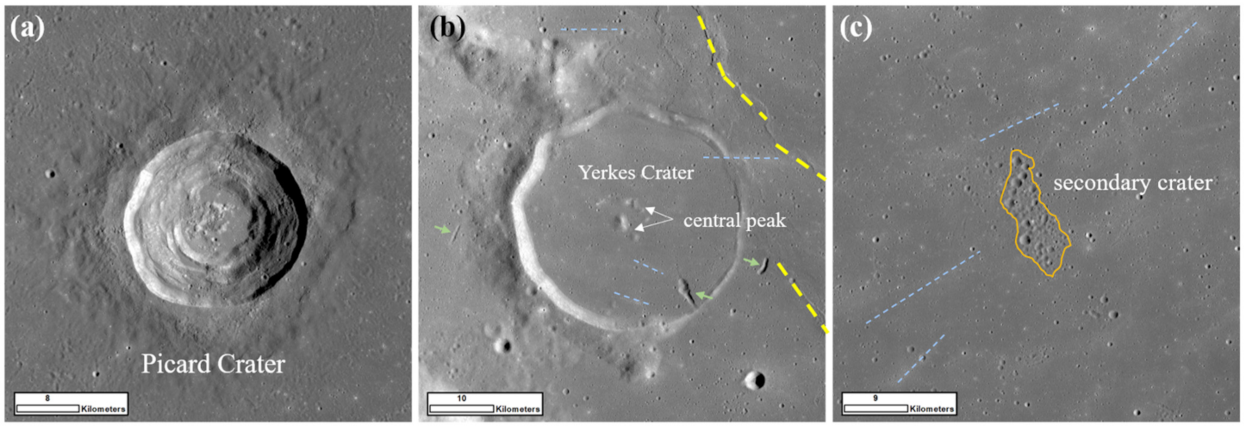
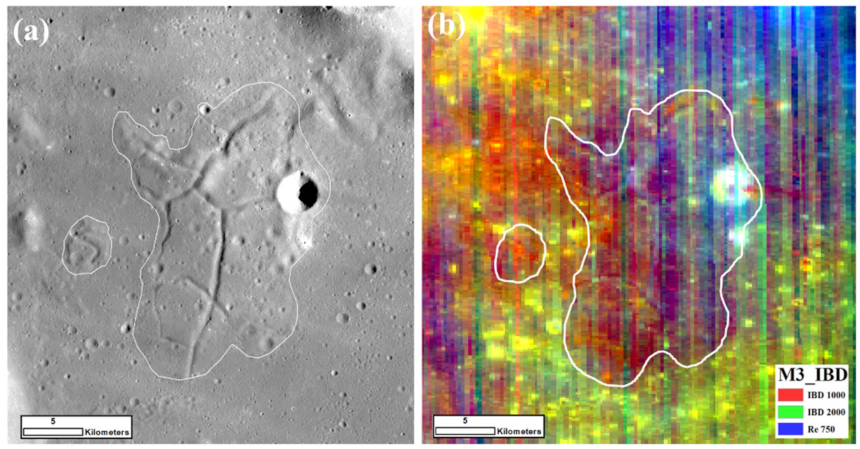

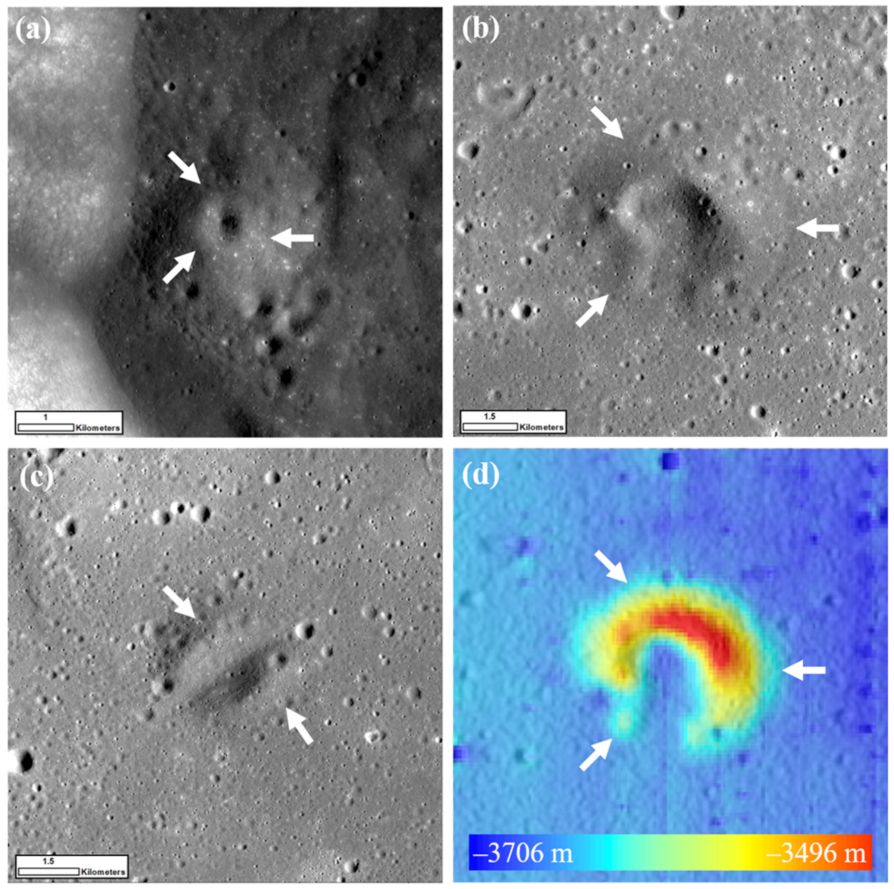

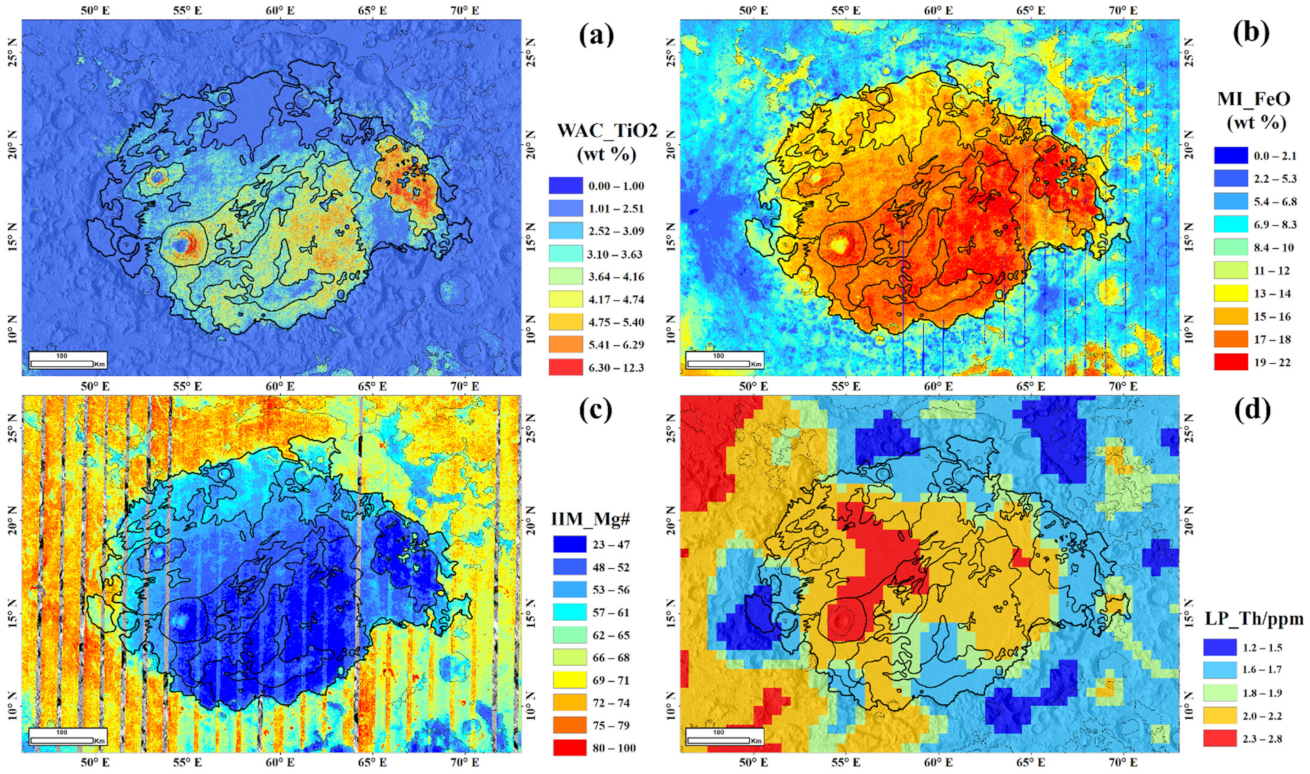
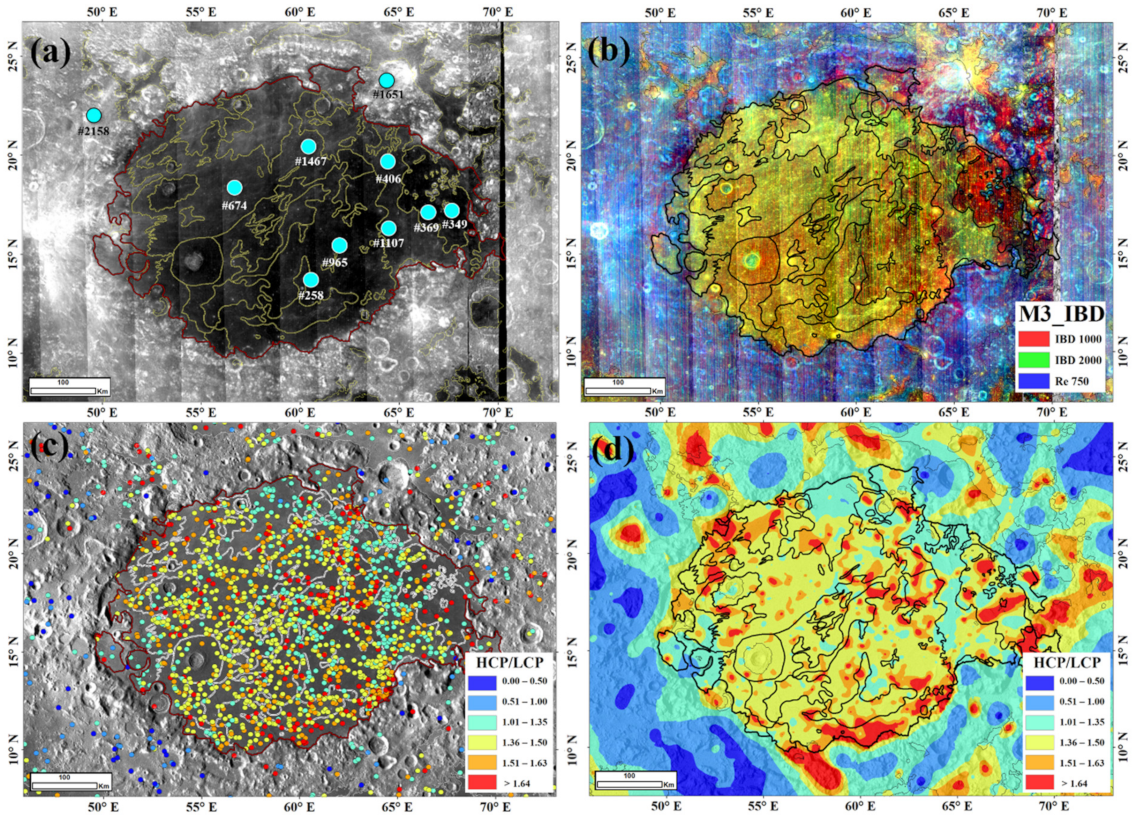
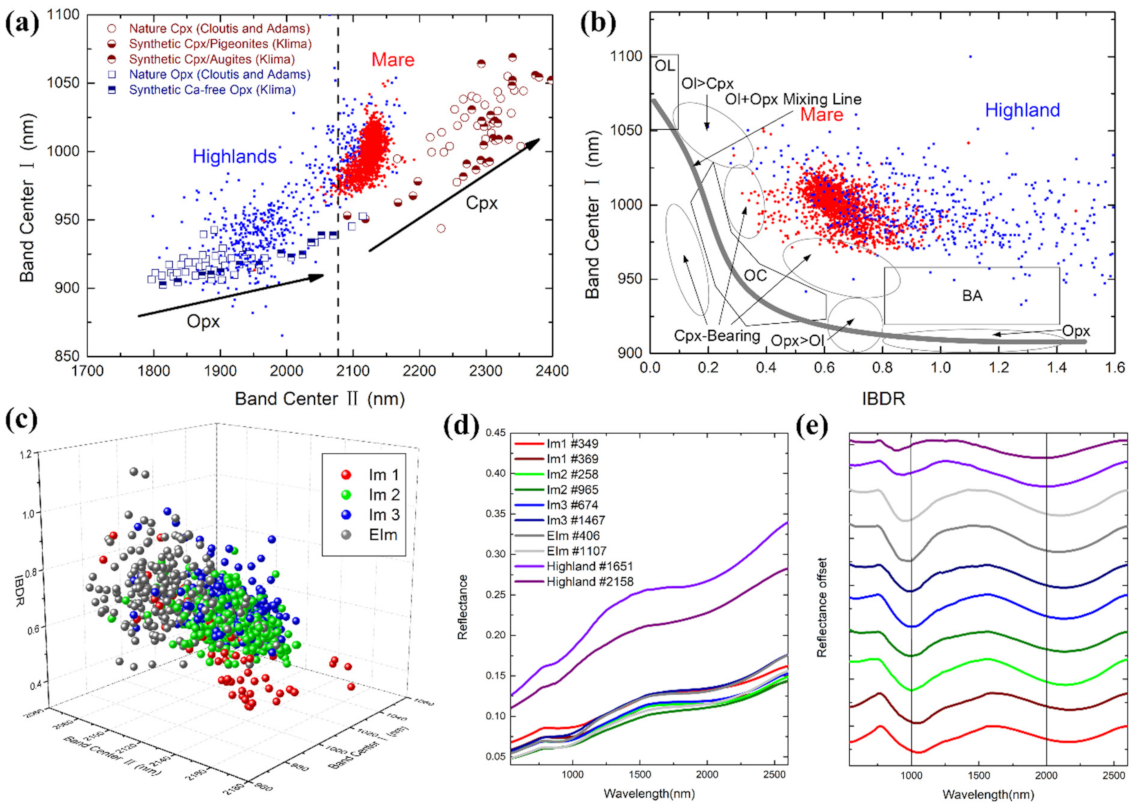
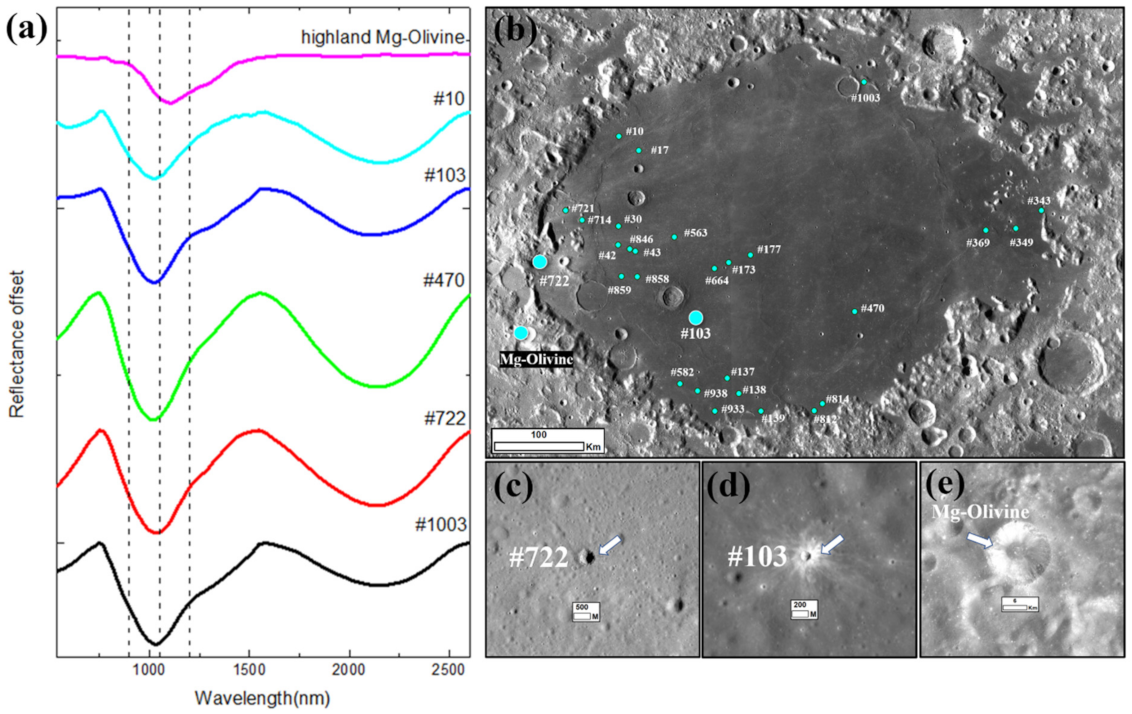
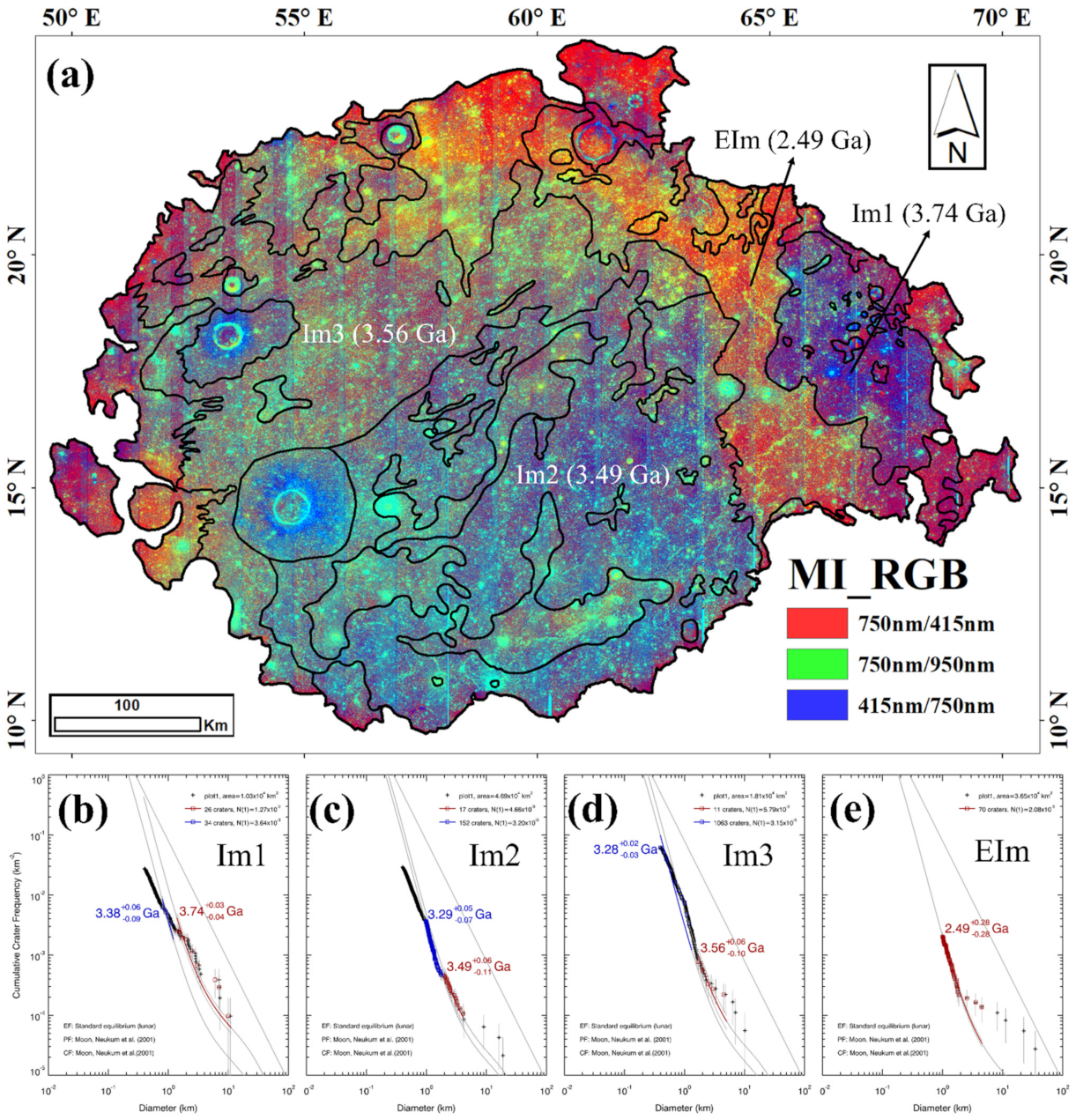

| Unit | Numder of Craters (D > 400 m) | Area (km2) | Model Ages in This Study (Kaguya-TC) | Hiesinger et al. (2011). (LROC-WAC) | Boyce et al. (1978) (Lunar Orbiter 5) | Average Values of Compisition | |||
|---|---|---|---|---|---|---|---|---|---|
| TiO2(wt.%) | FeO (wt.%) | Mg# | Th(ppm) | ||||||
| Im1 | 284 | 10,303 | 3.27/3.60 Ga | 3.2/3.5 Ga | 4.92 ± 1.17 | 17.1 ± 2.02 | 48.1 ± 3.54 | 1.73 ± 0.16 | |
| Im2 | 1372 | 46,904 | 3.04/3.49 Ga | 3.2/3.5 Ga | 3.85 ± 0.98 | 17.9 ± 1.65 | 47.5 ± 2.43 | 1.95 ± 0.20 | |
| Im3 | 1111 | 36,507 | 2.71/2.78 Ga | 3.5/3.65 Ga | 2.42 ± 0.92 | 15.5 ± 1.24 | 52.5 ± 2.60 | 2.11 ± 0.21 | |
| EIm | 477 | 18,070 | 2.95/2.97 Ga | 2.5/3.2 Ga | 2.02 ± 1.07 | 15.7 ± 1.82 | 52.9 ± 2.77 | 1.88 ± 0.17 | |
Publisher’s Note: MDPI stays neutral with regard to jurisdictional claims in published maps and institutional affiliations. |
© 2021 by the authors. Licensee MDPI, Basel, Switzerland. This article is an open access article distributed under the terms and conditions of the Creative Commons Attribution (CC BY) license (https://creativecommons.org/licenses/by/4.0/).
Share and Cite
Lu, X.; Cao, H.; Ling, Z.; Fu, X.; Qiao, L.; Chen, J. Geomorphology, Mineralogy, and Geochronology of Mare Basalts and Non-Mare Materials around the Lunar Crisium Basin. Remote Sens. 2021, 13, 4828. https://doi.org/10.3390/rs13234828
Lu X, Cao H, Ling Z, Fu X, Qiao L, Chen J. Geomorphology, Mineralogy, and Geochronology of Mare Basalts and Non-Mare Materials around the Lunar Crisium Basin. Remote Sensing. 2021; 13(23):4828. https://doi.org/10.3390/rs13234828
Chicago/Turabian StyleLu, Xuejin, Haijun Cao, Zongcheng Ling, Xiaohui Fu, Le Qiao, and Jian Chen. 2021. "Geomorphology, Mineralogy, and Geochronology of Mare Basalts and Non-Mare Materials around the Lunar Crisium Basin" Remote Sensing 13, no. 23: 4828. https://doi.org/10.3390/rs13234828








